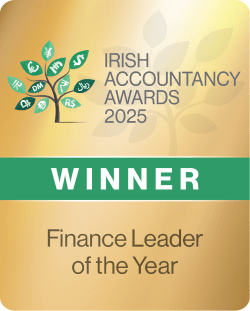The short answer: Yes, you should strongly consider topping up your pension if you have the financial means to do so. As financial advisors and accountants, we frequently see people miss out on valuable tax benefits and long-term savings opportunities by not contributing enough to their pensions.
Recent figures show that only 56% of Irish workers are actively contributing to their pensions. This means a significant portion of the population is not taking full advantage of one of the most powerful tools for securing their financial future. A pension top-up can provide substantial tax relief and help you build a more comfortable retirement.
In this guide, we’ll look at the key reasons why you should consider topping up your pension, the tax benefits, and practical tips to make informed decisions about your retirement savings.

The State Of Pensions In 2024
The Irish pension system has evolved significantly over recent years. With the state pension age now set at 66 and discussions about future increases, private pension planning has become more crucial than ever. Many business owners and professionals are realising that relying solely on the state pension might not provide the retirement lifestyle they envision.
The Basics
A pension top-up means adding extra money to your existing pension scheme. Whether you’re a business owner using Xero to track your finances or an employee managing personal contributions, understanding how top-ups work is crucial for your retirement planning.
Current pension options in Ireland include:
- Personal Retirement Savings Accounts (PRSAs)
- Occupational pension schemes
- Personal pension plans
- Self-administered pension schemes
Understanding Different Pension Types
Before deciding on a pension top-up, it’s important to understand exactly what type of pension you have and the specific rules that apply to it. Each pension type has different contribution limits, tax benefits, and access rules.
Personal Pensions (Personal Retirement Bonds)
Personal pensions serve as an excellent retirement planning tool, particularly for self-employed individuals and company directors who own more than 5% of their business. These plans offer remarkable flexibility, allowing you to adjust your contributions based on your business performance and personal circumstances.
The tax advantages make personal pensions particularly attractive. Your contributions receive tax relief at your marginal rate, while your pension fund grows tax-free. At retirement, you can generally take 25% of your fund as a tax-free lump sum, with the remainder providing your retirement income.
Tax-deductible contributions vary by age:
- Under 30: 15% of earnings
- 30-39: 20% of earnings
- 40-49: 25% of earnings
- 50-54: 30% of earnings
- 55-59: 35% of earnings
- 60 and over: 40% of earnings
To illustrate how this could work: A 45-year-old business owner earning €100,000 can contribute up to €25,000 annually with tax relief. At a 40% tax rate, the net cost would be €15,000, with the government effectively contributing €10,000 through tax relief.
Occupational Pension Schemes
Occupational pension schemes serve as powerful tools for company directors, key employees, and businesses focused on talent retention. They provide tax-efficient benefits while helping companies attract and retain valuable team members.
Three main types:
- Defined Benefit (DB) Schemes
These schemes provide guaranteed retirement income based on your salary and service years. While rare in the private sector, they offer valuable benefits:- Guaranteed retirement income
- Employer bears investment risk
- Strong security for retirement planning
- Annual actuarial oversight
- Defined Contribution (DC) Schemes
Modern and flexible, DC schemes link your benefits to contribution levels and investment performance. Key features include:- Retirement benefits based on fund value
- Shared contributions between employer and employee
- Flexible investment options
- Clear cost structure
- Executive Pension Plans
Designed specifically for company directors, these plans offer enhanced benefits:- Higher contribution limits
- Greater investment control
- Tax-efficient profit extraction
- Flexible retirement options
Funding options:
- Employee contributions
- Employer contributions
- Additional Voluntary Contributions (AVCs)
- Special one-off contributions
Personal Retirement Savings Accounts (PRSAs)
PRSAs offer a flexible pension solution that grows with your career. They’re particularly valuable for self-employed individuals with variable income and employees without access to company pension schemes. Their portability between employers makes them an attractive option for those who may change jobs frequently.
What’s New for PRSAs in 2025?
- Employer Contributions Capped at 100% of Salary
From January 2025, employer contributions to a director’s PRSA are capped at 100% of their annual salary. Contributions exceeding this limit will be treated as a Benefit-in-Kind (BIK) and taxed as personal income.
Example: If your annual salary is €50,000, the maximum employer contribution to your PRSA is €50,000. Any excess, such as €60,000, will see the additional €10,000 taxed as income. - Removal of Age-Related Contribution Limits
Since 2023, the old restrictions based on age-related salary percentages no longer apply. This means directors of all ages can contribute more flexibly to their PRSA. - No BIK on Employer Contributions
Employer contributions remain free from Benefit-in-Kind tax liability, ensuring tax-efficient growth of your pension pot.
How Much Can You Accumulate in Your PRSA?
The maximum pension fund allowable without incurring additional tax charges is governed by the Standard Fund Threshold (SFT):
- Current SFT: €2 million
- Future Increases: The SFT is set to rise incrementally:
- €2.2 million in 2026
- €2.4 million in 2027
- €2.6 million in 2028
- €2.8 million in 2029
This gives directors greater scope for long-term savings, but exceeding the SFT can lead to significant tax penalties.
How to Withdraw from Your PRSA
When you retire, PRSAs offer flexibility in accessing your savings:
- Tax-Free Lump Sum:
You can withdraw up to 25% of your fund as a tax-free lump sum, subject to limits:- First €200,000: Tax-free
- Next €300,000: Taxed at 20%
- Approved Retirement Fund (ARF):
The remaining 75% of your pension pot can be transferred into an ARF, from which you can make regular withdrawals. These withdrawals are subject to:- Income tax
- Universal Social Charge (USC)
- Pay Related Social Insurance (PRSI) where applicable
How Much Do You Need for Retirement?
To generate a retirement income of €50,000 per year, factoring in the Irish State Pension (currently €13,796 per year), you’ll need an additional €36,204 annually from your PRSA.
Using the 4% Rule (a guideline suggesting you can withdraw 4% of your fund annually without depleting it prematurely), the required pension pot is:
- €36,204 / 0.04 = €905,100
For younger directors, inflation must be considered. For instance, a director planning to retire in 20 years would need a pension pot closer to €1.2 million to achieve the same purchasing power.
Small Self-Administered Schemes (SSAS)
Small self-administered schemes work particularly well for family businesses and company directors looking to maximise their pension benefits. These schemes offer unique opportunities for business growth while building retirement wealth.
Key features that set SSAS apart from traditional pensions:
- Direct property investment allowed
- Loan back facility up to 50% of fund value
- Greater control over investment decisions
- Multiple member participation options
- Intergenerational wealth transfer opportunities
- Tax-efficient profit extraction
Your investment portfolio can include:
- Commercial property
- Listed shares
- Investment funds
- Corporate bonds
- Cash deposits
Investment rules and restrictions:
- All transactions must be at arm’s length
- Limited to 5% investment in sponsoring employer
- Professional trustee oversight required
- Assets must be for business use only
- All transactions must be commercial in nature
Property investment specific rules:
- Residential property is excluded (with limited exceptions)
- Properties must generate commercial rent
- Personal use is not permitted
- Commercial transactions only
Additional Voluntary Contributions (AVCs)
Additional Voluntary Contributions provide a valuable way to boost your retirement savings, especially for those already in occupational schemes or approaching retirement. For higher earners looking to maximise tax relief, AVCs offer a structured path to enhance retirement benefits.
Key benefits of choosing AVCs:
- Supplement your existing pension
- Access additional tax relief
- More retirement planning options
- Potential for extra tax-free cash
Planning your contributions can be done in several ways:
- Regular monthly payments
- Annual lump sum deposits
- Combined payment approaches
- Calculations based on career earnings

Long-Term Benefits Of Pension Top-Ups
Your pension isn’t just about tax savings. It’s about creating a stable financial future. Here’s how they help build long-term wealth:
- Compound Growth Benefits
Your investments grow tax-free within your pension fund, and this growth compounds over time. For example, €500 monthly invested over 30 years could grow to a significant sum at retirement. - Protection Against Inflation
Regular pension top-ups help ensure your retirement savings keep pace with rising living costs, protecting your future purchasing power. - Reliable Retirement Income
Building a larger pension pot through regular top-ups increases your chances of maintaining your desired lifestyle in retirement.
When Is The Right Time To Top Up Your Pension?
The question “should I top up my pension” becomes especially relevant during certain financial milestones.
Key times to consider pension top-ups:
- After increased business profits
- Following inheritance receipt
- During tax planning
- When receiving a salary increase
- Year-end tax planning periods
Pension Calculators And The Power Of Compounding
Understanding how your pension grows and using the right tools to plan ahead are essential for making informed decisions.
How Compounding Grows Your Money
Think of compounding as earning interest on your interest. The longer your money is invested, the more powerful this effect becomes.
A simple example shows why starting early matters:
- €200 monthly investment over 30 years at 6% = €200,903
- €400 monthly investment over 15 years at 6% = €116,803
Even though both scenarios invest the same total amount (€72,000), starting earlier with less gives you €84,100 more.
Using Pension Calculators
Most pension providers offer online calculators where you input:
- Your age
- Current pension value
- Monthly contributions
- Target retirement age
Two reliable free calculators:
- Revenue’s Pension Calculator: Shows your tax relief benefits
- CCPC Pension Calculator: Helps plan your retirement savings
Remember: Calculators are guides, not guarantees. Use conservative growth estimates (4-6%) when planning.
Calculating Your Optimal Pension Top-Up
Understanding how much to top up your pension requires careful consideration of your current situation and future goals. Let’s look at two possible examples that demonstrate different approaches to pension top-ups.
Case Study 1: Sarah’s E-commerce Business Journey
Sarah runs a successful online retail business and is thinking about increasing her pension contributions. Here’s her situation:
- Age: 42
- Current pension value: €200,000
- Annual business profit: €120,000
- Potential pension top-up: €30,000
- Tax savings: €12,000
Based on her age and earnings, Sarah can maximise her tax relief while building substantial retirement savings through strategic top-ups.
Case Study 2: Michael’s Creative Agency Planning
Michael’s growing agency presents different opportunities for pension planning:
- Age: 35
- Current pension value: €80,000
- Annual income: €85,000
- Regular monthly top-up: €500
- Annual tax savings: €2,400
At his age, Michael’s regular monthly approach allows him to benefit from long-term compound growth while maintaining flexibility for his growing business needs. His consistent contribution strategy aligns well with his younger age and business development stage.
Making Your Decision
Before deciding on pension top-ups, it’s necessary to evaluate your complete financial picture.
Consider these key areas:
- Current Financial Position
Understanding your financial foundation:- Emergency fund adequacy
- Business cash flow health
- Investment portfolio diversity
- Current debt obligations
- Retirement Planning
Defining your future needs:- Target retirement age
- Expected lifestyle costs
- Additional income sources
- Healthcare considerations
Smart Ways To Top Up Your Pension
Once you’ve decided to increase your pension contributions, it’s important to choose the right approach. Here are two effective strategies:
- Regular Monthly Increases
This systematic approach helps build consistent retirement savings:- Set up automated contributions
- Time them with monthly business income
- Begin with manageable amounts
- Gradually increase contributions yearly
- Annual Lump Sums
This strategy works well for businesses with variable income:- Align with tax year deadlines
- Use business surplus strategically
- Maximise annual tax relief
- Plan around business cash flow
Timing Your Top-Ups Effectively
Working with HMRC guidelines and understanding tax deadlines is crucial for optimal pension planning. For businesses using small business accounting services, timing can significantly impact tax efficiency and cash flow management.
Your Next Steps
Taking action on pension top-ups requires a structured approach:
- Review Your Current Position
- Gather existing pension statements
- Understand your contribution history
- Assess your retirement timeline
- Calculate Benefits
- Potential tax savings
- Long-term growth projections
- Impact on retirement income
- Get Professional Guidance
- Consult with pension specialists
- Review with your accountant
- Plan implementation timeline
- Regular Reviews
- Schedule annual pension checkups
- Monitor contribution levels
- Adjust strategy as needed
Remember, pension planning isn’t just about retirement, it’s about creating tax-efficient wealth for your future while managing your current business finances effectively. Here’s how we can help:
- Schedule a comprehensive pension review
- Analyse your current contributions
- Develop a tailored top-up strategy
- Create a long-term retirement plan
Contact Around Finance for personalised advice tailored to your business needs.
FAQs
Can I access my topped-up pension before retirement?
Generally, pension funds are locked until retirement age (currently 66 in Ireland), with some exceptions for ill health or specific circumstances.
How much can I top up my pension by?
Age-related limits apply, ranging from 15% to 40% of your earnings, subject to an earnings cap.
Will pension top-ups affect my state pension?
No, private pension contributions don’t impact your state pension entitlement.
Should I top up my pension or pay off debt?
It depends on the type and cost of debt – high-interest debt should typically be prioritized.
Can I make both regular and lump sum top-ups?
Yes, you can combine regular monthly contributions with annual lump sums for maximum flexibility.
Can my company contribute to my pension?
Yes, employer contributions are common and often offer tax advantages for both employer and employee.











